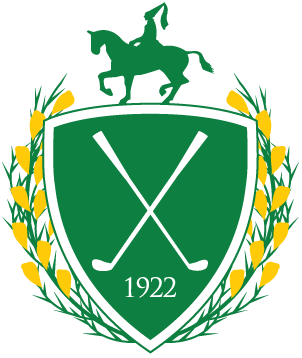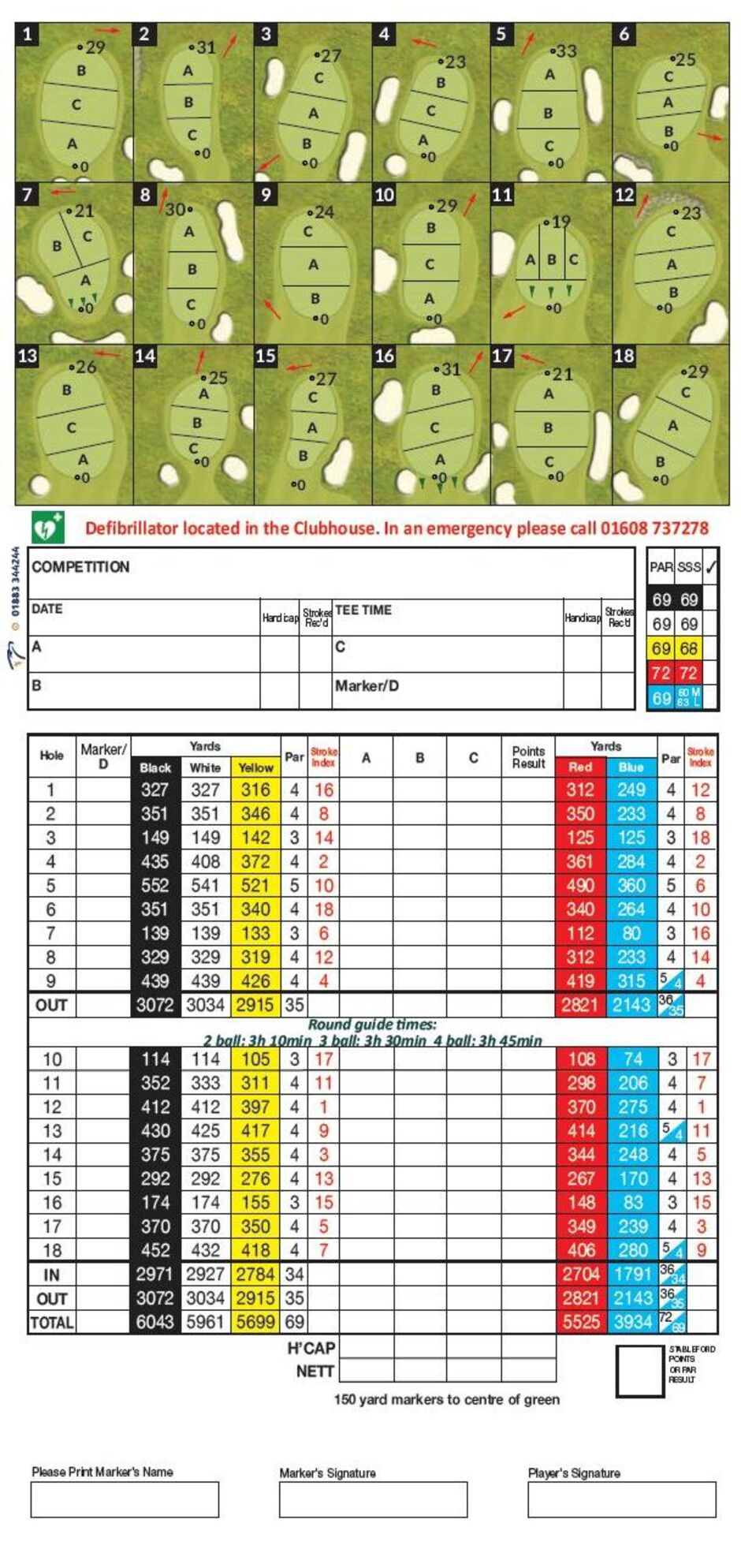Scorecard
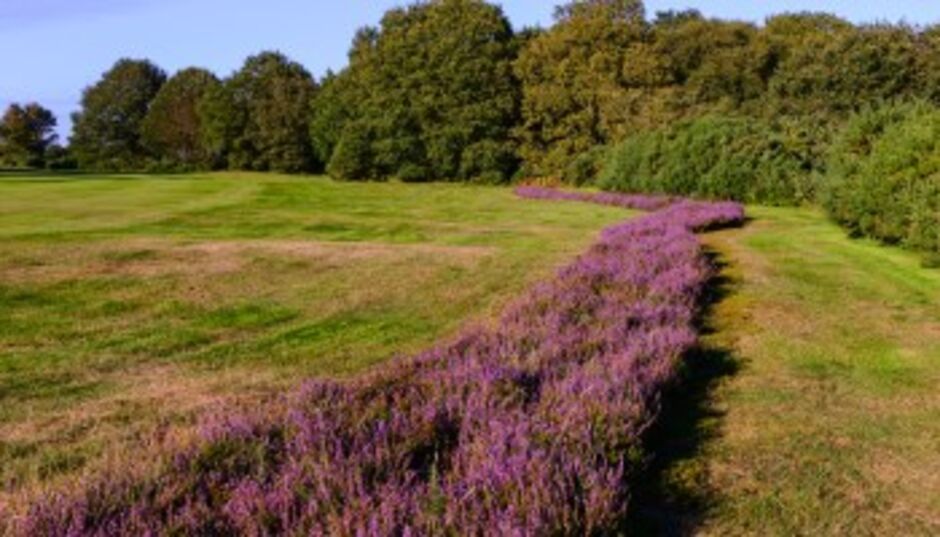
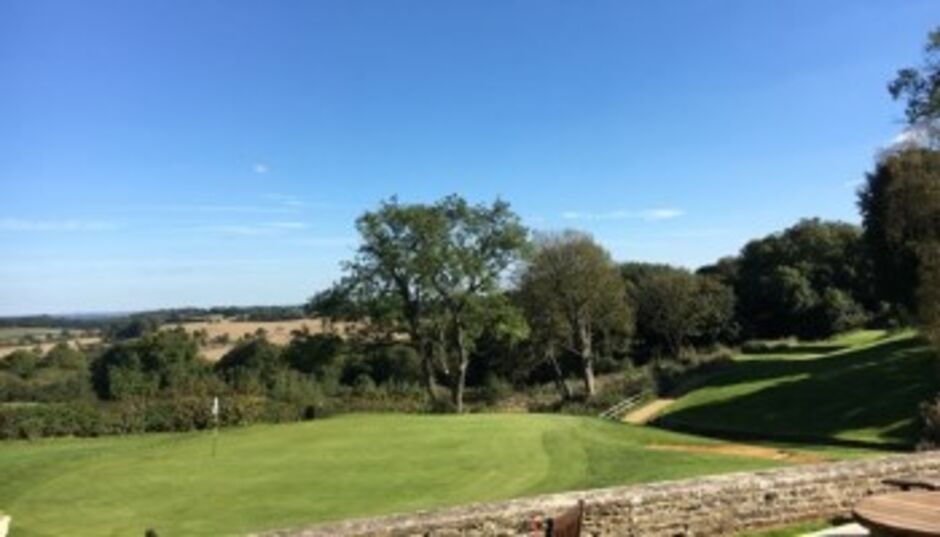
Local Rules
In addition to the Rules of Golf authorised by the R&A, the following Local Rules will apply.
(The full text here takes precedence over the abridged version on the scorecard)
1. Out of Bounds (Rule 27-1)
1-1 Beyond boundary fences and hedges; on or over boundary walls; in or over boundary ditches (identified by a white stake with a black top, such stakes are movable obstructions). Where a fence is present it always defines the boundary
1-2 Beyond white stakes, on or over adjoining or broken white lines (e.g. across car park entrances)
1-3 Within the premises of the clubhouse, professional's shop, changing rooms, offices and the car parks
2. Water Hazard (Rule 26)
2-1 The margin of the water hazard on the 7th hole is the inside waterside edge of the timber sleepers above the stone walls and the continuing yellow stakes around the stream. When a yellow line is present it defines the margin.
2-2 If it is known or virtually certain that a ball that has not been found is in the water hazard on the 7th hole the player may proceed under Rule 26 or as an additional option drop a ball under penalty of one stroke in the Dropping Zone if one is provided. If an artificial turf dropping zone is present then the mat defines the dropping zone. The dropped ball must first strike the mat and does not have to stay within the dropping zone. The ball is in play if it rolls up to two club lengths in any direction from the point where it first struck the course (including nearer to the hole).
3. Ground Under Repair (Rule 25-1)
3-1 White lines within the course define ground under repair
3-2 Horses' hoof marks
4. Stones in Bunkers are movable obstructions (Rule 24-1)
5. Immovable Obstructions (Rule 24-2)
5-1 The road on the 8th hole; the artificially-surfaced path on the 7th hole. All other paths, tracks and bridleways are integral parts of the course.
5-2 Immovable Obstructions Close to Putting Green: All fixed sprinkler heads are immovable obstructions and relief without penalty is available under Rule 24-2. In addition, if a ball lies through the green and an immovable obstruction on or within two club-lengths of the putting green and within two club-lengths of the ball intervenes on the line of play between the ball and the hole, the player may take relief without penalty as follows: the ball must be lifted and dropped at the nearest point to where the ball lay that a) is not nearer the hole, b) avoids intervention and c) is not in a hazard or on a putting green.
5-3 Protection of Young Trees and Bushes: Identified by stakes or cages. If such a tree or bush interferes with a player's stance or the area of intended swing, the ball must be lifted without penalty and dropped within one club length of the nearest point of relief using the procedure in Rule 24-2b (Immovable Obstructions)
6. Integral Parts of the Course
6-1 Paths, tracks and bridleways. Exception: hole 7 path
6-2 The timber sleepers in the bunker on the 6th hole when the ball lies in the bunker
6-3 The stone wall to the left of the 4th green
6-4 The stone walls of the clubhouse complex and all attachments e.g. drainpipes, taps, doors, stone steps, french windows etc.
7. Distance Measuring Devices:For all play at this course a player may obtain distance information by use of a distance-measuring device. If, during a stipulated round, a player uses a distance-measuring device to gauge or measure other conditions that might affect his play (e.g. elevation changes, wind speed, etc.), the player is in breach of Rule 14-3."
PENALTY FOR BREACH OF LOCAL RULES 2-2, 5-2, 5-3:
Match Play: Loss of hole Stroke Play: Two strokes
In addition to the Rules of Golf authorised by the R&A, the following additional temporary LOCAL RULES will apply only in WINTER
(The full text here takes precedence over the abridged version on the scorecard)
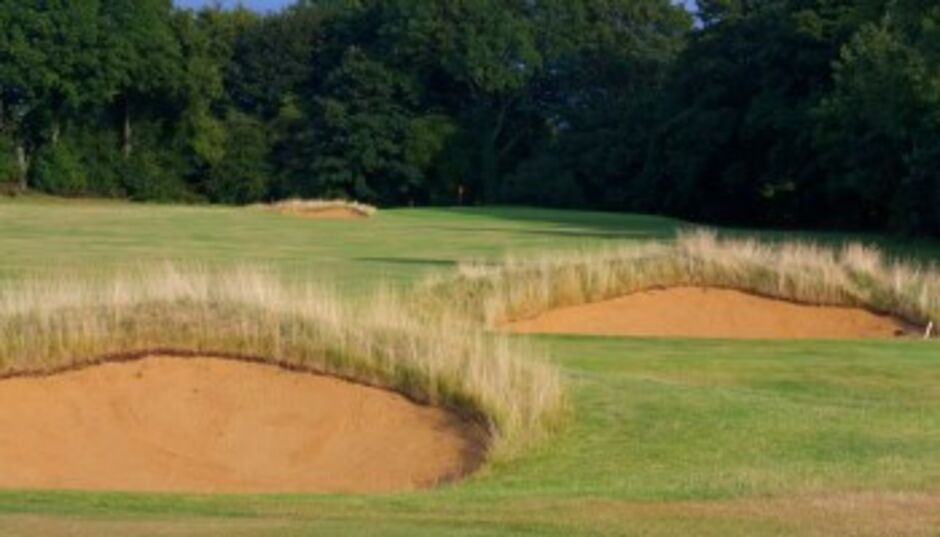
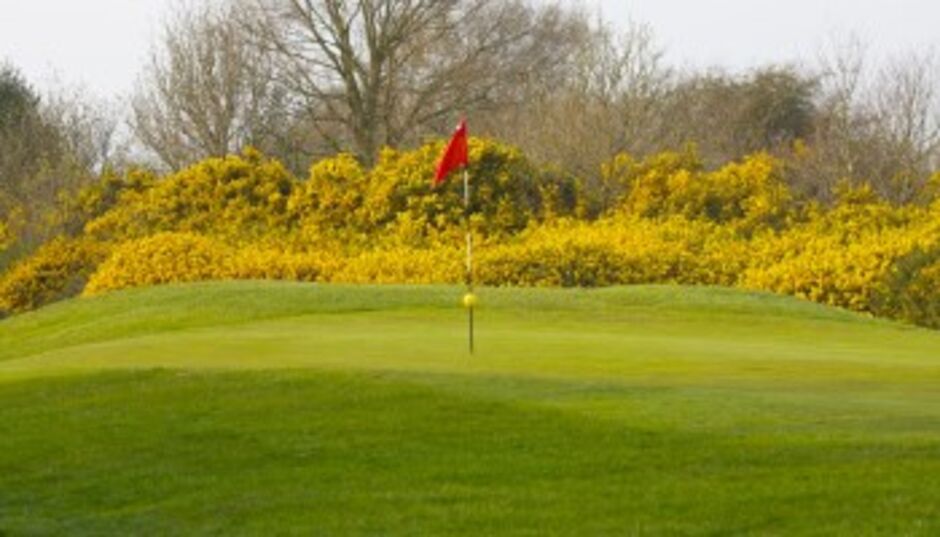
8. Winter Rules
8-1 Lift, Clean and Place: A ball lying on a closely-mown area through the green may be lifted, without penalty, and cleaned. Before lifting the ball, the player must mark its position. Having lifted the ball, he must place it on a spot within six inches of and not nearer the hole than where it originally lay, that is not in a hazard and not on a putting green.
A player may place his ball only once, and it is in play when it has been placed (Rule 20-4). If the ball fails to come to rest on the spot on which it is placed, Rule 20-3d applies. If the ball when placed comes to rest on the spot on which it is placed and it subsequently moves, there is no penalty and the ball must be played as it lies, unless the provisions of any other Rule apply.
If the player fails to mark the position of the ball before lifting it or moves the ball in any other manner, such as rolling it with a club, he incurs a
penalty of one stroke.
Note: "Closely-mown area" means any area of the course, including paths through the rough, cut to fairway height or less.
8-2 Aeration Holes: Through the green, a ball that comes to rest in or on an aeration hole may be lifted, without penalty, cleaned and dropped, as near as possible to the spot where it lay but not nearer the hole.
On the putting green, a ball that comes to rest in or on an aeration hole may be placed at the nearest spot not nearer the hole that avoids the situation
8-3 Embedded Ball (Rule 25-2): Through the green, a ball that is embedded in its own pitch-mark in the ground may be lifted, without penalty, cleaned and dropped as near as possible to where it lay but not nearer the hole. The ball when dropped must first strike a part of the course through the green.
Exceptions:
1. A player may not take relief under this Local Rule if the ball is embedded in sand in an area that is not closely mown.
2. A player may not take relief under this Local Rule if interference by anything other than the condition covered by this Local Rule makes the stroke clearly impracticable.
8-4 Temporary Putting Greens (Rule 25-3): Interference by a wrong putting green occurs when a ball is on the wrong putting green. Interference to a player's stance or the area of his intended swing is not, of itself, interference under this Rule. If a player's ball lies on a wrong putting green (including a temporary winter green), he must not play the ball as it lies. He must take relief, without penalty, as follows:
The player must lift the ball and drop it within one club-length of and not nearer the hole than the nearest point of relief. The nearest point of relief must not be in a hazard or on a putting green. When dropping the ball within one club-length of the nearest point of relief, the ball must first strike a part of the course at a spot that avoids interference by the wrong putting green and is not in a hazard and not on a putting green. The ball may be cleaned when lifted under this Rule.
8-5 Artificial Tee Mats (Rule 11): Artificial tee mats comprise the teeing ground. When starting a hole from an artificial tee mat the player must take his stance on, and play a ball from, the mat, Rule 11-4b applies:
If a competitor, when starting a hole, plays a ball from outside the teeing ground, he incurs a penalty of two strokes and must then play a ball from within the teeing ground. If the competitor makes a stroke from the next teeing ground without first correcting his mistake or, in the case of the last hole of the round, leaves the putting green without first declaring his intention to correct his mistake, he is disqualified. The stroke from outside the teeing ground and any subsequent strokes by the competitor on the hole prior to his correction of the mistake do not count in his score.
PENALTY FOR BREACH OF LOCAL RULES 8-1 and 8-2:
Match Play: Loss of hole Stroke Play: Two strokes

